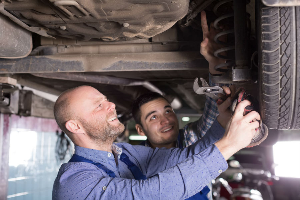You keep your car's engine purring with regular maintenance and upgrades, but what's underneath your vehicle as a whole can be almost as important as what's under the hood. The right tires and wheels can dramatically enhance any vehicle's functionality, whether you drive a high-performance sports car or a compact commuter car.
In this blog, we list aspects of your tires' condition or specifications and explain how each aspect can impact performance.
Alignment
Tire alignment refers to the position of your tires relative to the body of your car. When correctly aligned, your tires are perpendicular to the pavement and situated directly under axes on the frame. This position allows your tires to grip the road properly as you drive.
Misalignment can happen in any direction, usually due to driving over potholes or poorly maintained roads that jostled the suspension. Misalignment can decrease your gas mileage and make it difficult to control your vehicle.
Incorrect alignment can also cause your tire tread to wear unevenly over time. Tread issues can also have a large impact on your vehicle's performance, as discussed in the last section.
Pressure
The metric of tire pressure describes how much air or nitrogen is in your tires. Both high tire pressure and low tire pressure can negatively impact vehicle performance.
High Pressure
When tires are overinflated, they don't respond to the surface of the road as well. This immobility decreases traction and makes normal driving more noisy. You may also notice more bouncing and your tires will be more likely to go out of alignment.
Low Pressure
Inadequate tire pressure puts the tire in more contact with the road, which increases resistance. You may have more trouble getting up to speed, turning sharp corners, or responding quickly to road conditions.
Correct tire pressure differs according to tire type and according to season. For example, you may need to increase your tire pressure in the winter to avoid natural pressure loss due to cold temperatures.
Rigidity
The term "rigidity" refers to the hardness or softness of your tires. Rigidity in new tires comes from the way the tires are made. Older tires may become softer or harder depending on the environment. Tires tend to be marginally softer in extremely high temperatures that begin to melt the rubber slightly. Soft tires provide more grip on the road, but also wear down much faster than hard tires.
New hard tires are well suited for difficult terrain. However, tires can become harder and more brittle if they develop dry rot, and these tires are not safe for driving. Unlike other types of rot, dry rot is not an organic growth. Rather, dry rot describes tires that have less oil in the rubber than they should. This deficiency creates both hardness and crumbliness.
Tread Depth
The tread on your tires creates traction, giving you the ability to speed up and stop quickly. When your tread begins to wear out, your tires may be less responsive. Additionally, shallow tread provides less protection from hydroplaning and slipping on ice because the tread cannot adequately redirect water.
In order to be compliant with the law, your treads must be at least 1/16 of an inch deep. However, most tire experts recommend that you consider replacing your tires when they wear down to about 1/8 of an inch deep.
Maintain your tires and replace them as needed to ensure that your vehicle operates safely and smoothly.
Does your vehicle need new tires to restore its full driving potential? Extreme Wheels offers competitively priced high-quality tires for most vehicle types to help you conquer the road ahead.
OUR GUARANTEE
We’ll beat any lower advertised price! In our effort to be the largest rim distributor, we are constantly adding new wheel brands. Don’t see your favorite wheel line? Send us an email and we’ll look into getting them listed!
QUICK LINKS
LOCATION
Hours: Monday - Friday 8:00am to 6:00pm
Weekends: Saturday - 9:00am to 3:00pm
Address: 1497 E. Baseline Rd. Suite 4-109
Gilbert, AZ 85233
E-mail: info@ExtremeWheels.com
Phone: 480-892-9433
![]()








0 Comments